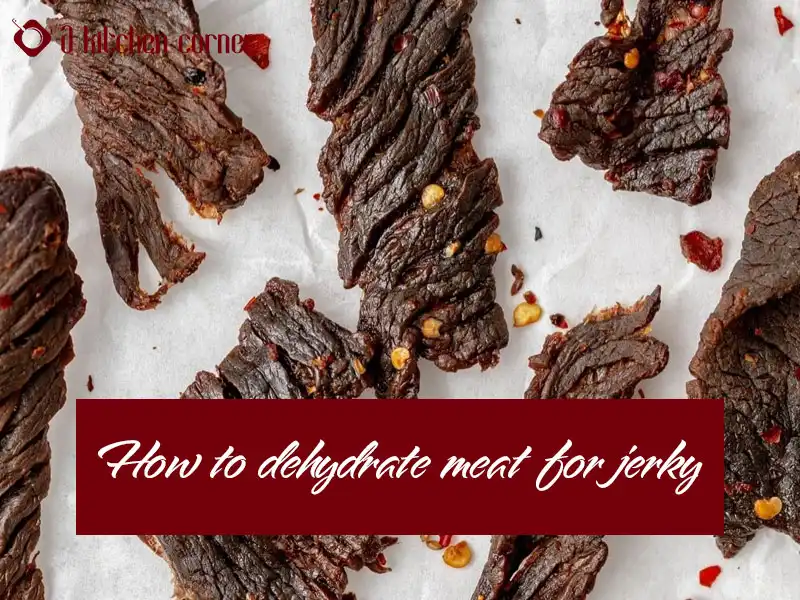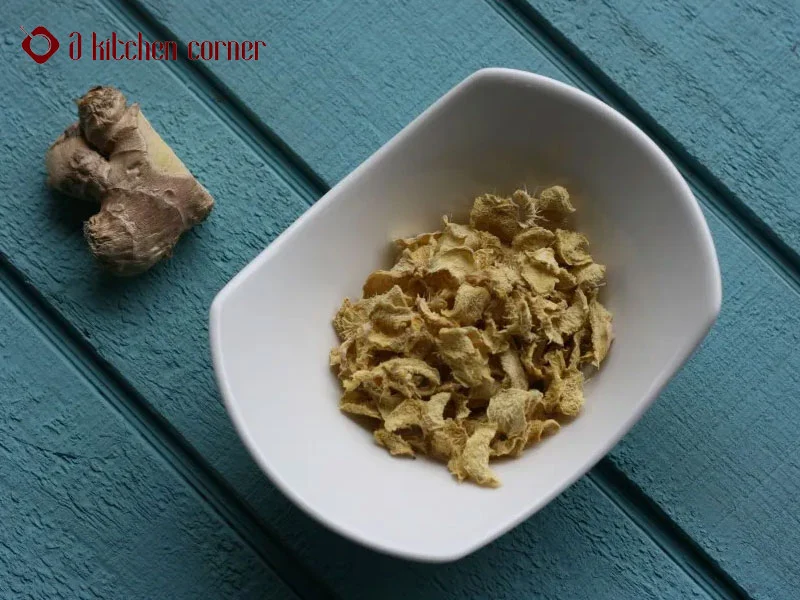Top 5 Best Dehydrator For Jerky – Reviews and Buying Guide

There are many ways to turn the meat into jerky, including the traditional hang-and-dry method, your oven, and your smoker. Using a food dehydrator is the most effective method for producing delicious jerky.
The challenge is finding the best dehydrator for jerky that meets your needs while not costing an arm and a leg for something rarely used in most kitchens. We comprehend the difficulty in sifting through the many items and the dubious claims makers make to market them.
We’ve reduced the options to five that will satisfy the needs of practically everyone. One of our favorites, COSORI Food Dehydrator, is the source of our top pick. The 10-Tray Food Dehydrator meets all your effectiveness, use, and pricing needs. Additionally, it has an excellent appearance.
Contents
- 1 The Top 5 best dehydrator for jerky in 2023
- 1.1 The best dehydrator for jerky overall – COSORI Food Dehydrator Machine
- 1.2 Best dehydrator for jerky under $100: Presto food dehydrator
- 1.3 Best for home use: Nesco dehydrator snackmaster pro
- 1.4 Best mid-range dehydrator: Hamilton Beach Digital Food Dehydrator
- 1.5 Best Commercial jerky dehydrator: Excalibur 9-Tray Electric Food Dehydrator
- 2 Choosing the best dehydrator for jerky: Qualities to consider
- 3 Dehydrator vs smoker for jerky – Do you need a dehydrator to make jerky?
- 4 Frequently asked questions
- 5 Final thoughts
The Top 5 best dehydrator for jerky in 2023
The best dehydrator for jerky overall – COSORI Food Dehydrator Machine
COSORI Food Dehydrator’s large capacity, strong fan, and precise thermostat produced evenly completed jerky in a short time with minimal tray movement.
This is the best dehydrator for jerky producers since it has a wide drying area, a quick drying time, a quiet fan, and the most consistent top-to-bottom drying rates.
Features
- Ten trays capacity.
- Metallic construction.
- Quiet, powerful fan.
- Quick drying time.

The best dehydrator for jerky overall – COSORI Food Dehydrator Machine
Pros
- Huge Capacity: Bulk drying is a breeze with enough trays and room for 10 pounds of jerky. You shouldn’t need to change trays because the 360-degree air circulation provides equal cooking for each component.
- Convenient Cleaning: Because the stainless steel wire trays are dishwasher safe, there is no need to scrub them by hand. The fruit roll tray also serves as a drip pan for simple cleanup.
- Thermostat control: Thanks to the dehydrator’s simple temperature and timing settings, you won’t have to watch it carefully or try to predict when your product is done. No matter what you’re dehydrating, regulate your temperature and drying time for the greatest results.
- High-quality Construction: This best dehydrator for jerky is made of high-quality stainless steel. It has a professional appearance and feel. Robust yet not overly weighty.
Cons
- Big footprint: A huge footprint accompanies a large capacity. As it won’t fit under a standard kitchen counter, you’ll need a special space to store this dehydrator.
- Tight Fit: Some of the stainless steel trays in the dehydrator’s center racks didn’t slide in with ease. They needed to be lightly pressed into position but slipped more easily with continued use. It didn’t scratch or damage the inside, so hopefully, they’ll loosen up even more with time.
Whether drying jerky, fruits, or veggies, the COSORI Food Dehydrator is a workhorse perfect for anyone drying big quantities of food.
Best dehydrator for jerky under $100: Presto food dehydrator
This dehydrator is very user-friendly and inexpensive. There is no need to bother with temperature settings; you can immediately set it up and begin your most recent batch of jerky.
It enables you to monitor the progress of your food’s drying without disturbing it. When you’re done, cleaning and putting it away is also simple.

Best dehydrator for jerky under 100$: Presto
Pros
- Transparent cover: By just peeping through the top of the unit, you can monitor the development of your jerky. It is much simpler than having to remove the trays by hand.
- Simple storage: The trays nest next to one another, and the corridor runs around the base, making storage simple.
- Dishwasher-friendly trays: After using them, you can quickly clean them by placing them in the dishwasher.
- Expandable size: It has four trays, and you can add another four trays to increase capacity.
Cons
- Just four trays: This dehydrator’s initial size leaves something to be desired. Large amounts of jerky cannot be stored in the available space.
- No temperature controls: The temperature is set at 165°F and cannot be changed. Lack of control can be problematic if you prefer your jerky to be 160°F or with certain foods.
Because of its reasonable price, Presto food dehydrator will be the best dehydrator for jerky under 100$ you can buy with a limited budget.
Best for home use: Nesco dehydrator snackmaster pro
This vertical dehydrator is simple to operate, expands to a bigger capacity, and has a little carrying handle. It provides effective results for food that is placed correctly beneath the air currents thanks to a top-mounted fan that generates 600 watts of drying power.
Also, it has some respectable temperature settings to simplify your snack-making activities.
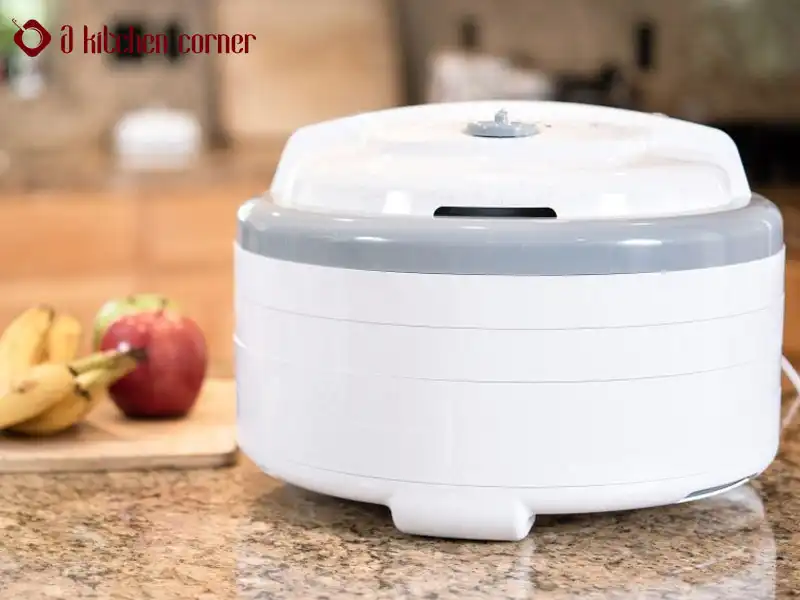
Best for home use: Nesco dehydrator
Pros
- More trays are available for purchase: five are included by default, but you may also get an additional seven. This makes it possible to dry food in large quantities, such as jerky or other foods.
- Silent: Even after several hours of operation, this dehydrator won’t irritate you. The mild hum shouldn’t annoy anyone, so feel free to place this in the kitchen.
- Decent vertical drying: This dehydrator uses a revolutionary flow drying technology to force air down and across your meat for decent vertical drying. The search for meat in the center of the stacks is rigorous.
- UV-resistant exterior: When food is dried, the Vita-Save shell blocks out damaging UV radiation to preserve its nutritional value.
Cons
- Uneven drying: While functional, the top-down design is less effective than dehydrators with fans at the back.Uneven drying— While functional, the top-down design is less effective than dehydrators with fans at the back.
- Trays are inexpensive: There are times when a tray will be warped because of the heat. You must acquire a new one because of this.
>> Related post: Nesco Dehydrator Recipes
Best mid-range dehydrator: Hamilton Beach Digital Food Dehydrator
This dehydrator has several fantastic technical features, including an auto shut-off timer and an adjustable thermostat, that make it a great kitchen assistant.
It’s also excellent for preparing other dishes, like fruit rolls, besides jerky. Five stacking trays may be dried effectively with the help of a strong 500-watt motor.
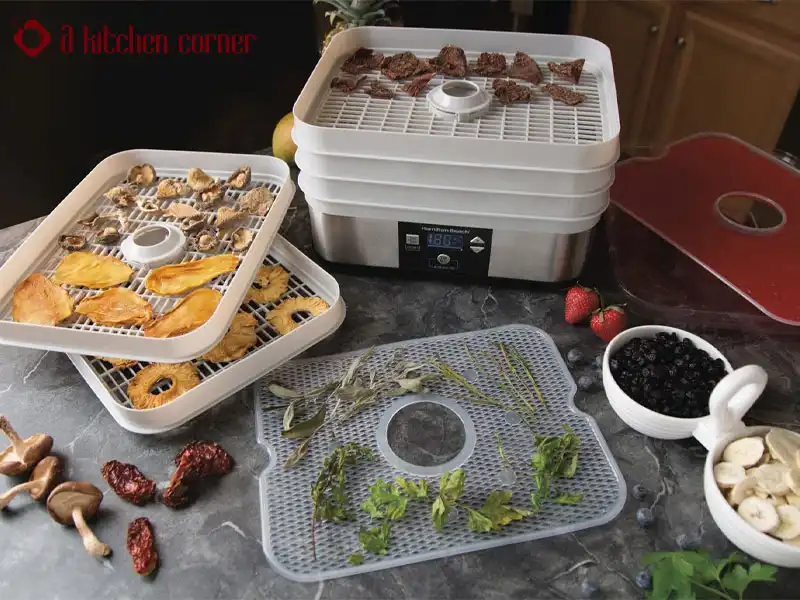
Best mid-range dehydrator: Hamilton Beach Digital Food Dehydrator
Pros
- Timer: You can use the auto-shutoff feature or set your jerky to run for up to 48 hours. It works well for drying your jerky without requiring you to keep an eye on the machine the entire time.
- Adjustable thermostat: With just a few button presses, choose between 100°F and 160°F.
- Two specialty sheets: A fine mesh sheet for drying herbs and other small foods are included with the purchase. A sturdy sheet is also included for creating your fruit rolls.
Cons
- Quite loud: This dehydrator is quite loud compared to the others we’ve examined.
- Most trays have substantial grids: To fit on the grids of these trays, make sure your jerky is sliced wide enough. Otherwise, they risk losing their balance due to dehydration.
Best Commercial jerky dehydrator: Excalibur 9-Tray Electric Food Dehydrator
The Excalibur 9 tray digital hydrator has all the tools you need to produce huge quantities of jerky and includes nine distinct trays with a total combined space of 15 square feet. You may observe the entire operation from the front window.
It includes many controls to simplify dehydration and a huge 7-inch fan that circulates a ton of air quietly and effectively.
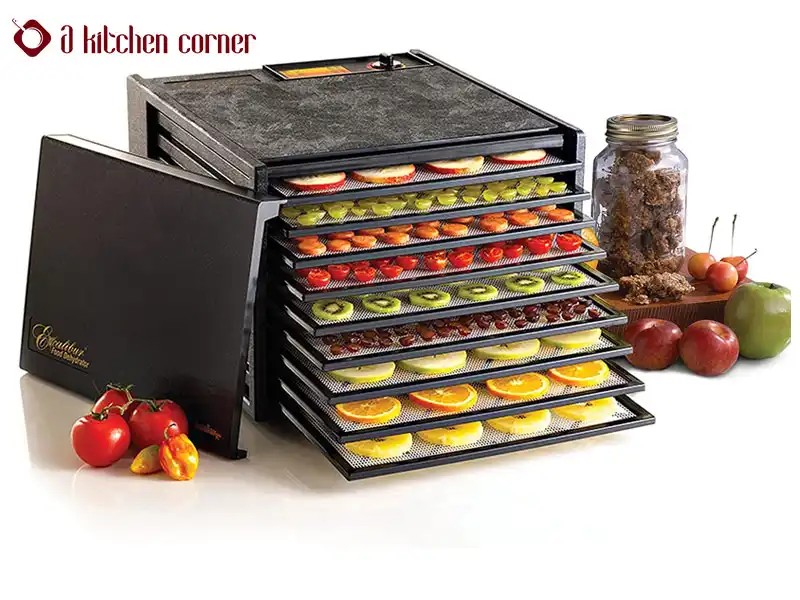
Best dehydrator for jerky commercials: Excalibur 9-Tray Electric Food Dehydrator
Pros
- Thermostat: The thermostat makes it simple to regulate the temperature of this dehydrator. A button press will raise the temperature to 165°F, which is considered safe for chickens.
- Fifteen square feet of room: Having enough room to stack different meats or vegetables is a major plus. Jerky and other dried foods can be prepared in bulk at once.
- Set and Forget: The thermostat controls come with a timer. As you wait for your jerky to be ready, it’s perfect for setting the dehydrator so you can carry out other tasks.
- Non-stick insert: Food does not adhere to the poly-tray design because of the non-stick insert. Please make something with sugar other than jerky. Nobody likes taking a lot of time to clean their dehydrator.
- Quiet operation: If you prepare jerky frequently, a noisy dehydrator sitting on your bench can become grating. Because of how quietly this model operates, it shouldn’t be irritating.
Cons
- Several people appear to have received damaged units due to inadequate packaging. I don’t know if this is a problem with Amazon or the manufacturer, but when you initially set it up, make sure everything is functioning properly.
- It can be challenging to start up this dehydrator for the first time without a tiny manual to explain how things function.
>> Related post: Cosori Dehydrator vs Excalibur: Which One is Right for You?
Choosing the best dehydrator for jerky: Qualities to consider
There are a few essential characteristics of the best dehydrator for jerky that you should look for when shopping.
Vertical/horizontal airflow
Dehydrators frequently use either of these two types of airflow. Each has advantages and downsides, but neither is necessarily better.
- Fans installed at the top or bottom of the device are a feature of vertical airflow dehydrators, which are typically inexpensive.
- These can be a wonderful option if your kitchen counter is busy because they are smaller than horizontal dehydrators.
- Yet, they don’t perform nearly as well as horizontal dehydrators.
This is because not the length of any given piece of meat is covered by air flowing up or down through the dehydrator. As a result, drying and moisture evaporation proceed a little more slowly.
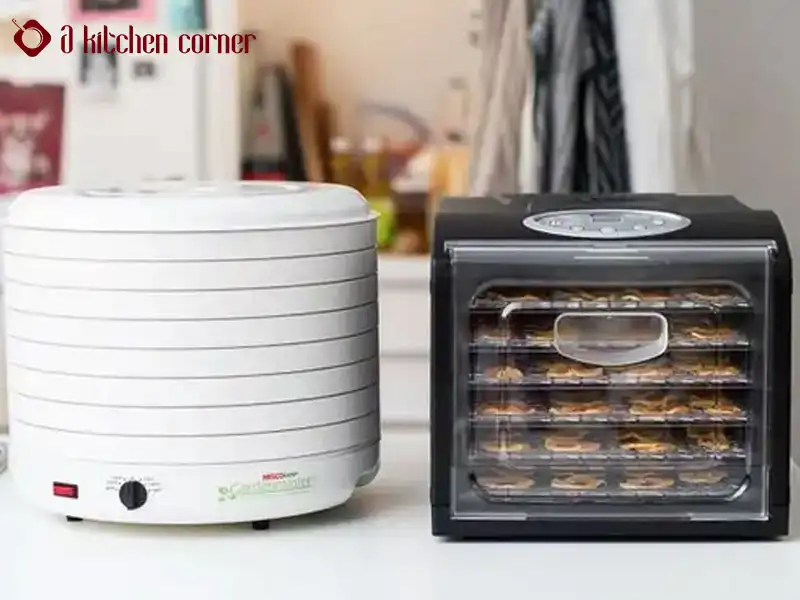
Depending on your demands, the best dehydrator for jerky can be vertical or horizontal.
Try rotating the racks in your vertical airflow dehydrator to compensate for this.
- Dehydrators with horizontal airflow have fans at the back of the machine.
- Every dehydrator shelf can receive the same level of air circulation thanks to the fan’s location.
- A strip of meat is airbrushed along its length, enhancing moisture evaporation and guaranteeing equal drying throughout.
With a horizontal jerky dryer, it’s also simpler to inspect your meat racks. Often, these trays swing out like a drawer or shelf that can be removed. In this way, adding or removing meat is simple.
Capacity
Your dehydrator’s size is quite important. Smaller units can simultaneously dehydrate less jerky than bigger ones.No matter what jerky dryer you choose, drying meat takes a long time.
Hence, rather than creating smaller batches of jerky whenever the want for a meaty snack strikes, you should create a large amount of it in preparation.
Essentially, decide how much jerky you intend to consume before choosing which is the best dehydrator for jerky.
If you enjoy jerky as your go-to daily snack, purchase a larger unit, even if it is more expensive. If you only sometimes eat jerky, you might also get a smaller dehydrator.
Temperature settings
Best dehydrator for jerky that incorporates temperature controls into their designs are worth looking into. Managing temperature is a huge advantage when producing your jerky because it is so important.
Jerky must have an internal temperature of 160°F unless it is poultry, in which case it must be 165°F. Thanks to temperature settings, you may effortlessly prepare your jerky at this preset-safe level without checking the temperature regularly.
Consider acquiring a temperature probe if you buy a jerky dryer without precise temperature settings.
You can always pre-heat the jerky to 160°F in the oven if your dehydrator doesn’t reach that temperature. When it is completely dry, you can put it in the dehydrator.
Nevertheless, doing this requires more time than just tossing the jerky into the dehydrator in the first place.
Noise level
Don’t forget to look at the best dehydrator for jerky with a low noise level. Since these machines use fans and moving air to dry your beef strips, they can be pretty noisy.
The instruction manual or product specifications for each dehydrator should contain information on the precise noise levels.
Dehydrators cost more frequently have soundproofing or quieter fans. They improve their comfort level over prolonged use.
Inexpensive equipment will likely be noisier overall. If you intend to use your dehydrator regularly, you will undoubtedly want a quieter one.
Dehydrator vs smoker for jerky – Do you need a dehydrator to make jerky?
Delicious jerky may be made without a dehydrator, but it simplifies the job. You can use a smoker or an oven to prepare your own jerky. On our website, you can easily get instructions on how to dehydrate meat with these devices.
All three of these devices can produce delicious jerky; let’s compare them. You may produce jerky in a regular oven by slicing the beef into tiny strips and placing them on baking trays. Increase the oven’s heat and observe the meat while it cooks and dries out.
Using a dehydrator to make jerky
Meat strips are dried in dehydrators using airflow. The increased warmth and airflow render the meat safe for consumption while evaporating moisture from the strips.
Pros
- They can be put away out of the way when not in use.
- They have plenty of room on the racks or shelves to fit a large amount of jerky at once.
- Dehydrators are often also more temperature-controllable.
- In addition to drying jerky, dehydrators can also be used to dry other kinds of food.
Cons
- When in operation, dehydrators do take up some counter space.
- Unless you choose a more expensive machine with built-in soundproofing technology, some affordable versions can operate noisily.
- Jerky can usually be dried in the oven much faster than in a dehydrator. Although the jerky will generally be of higher quality, you’ll have to wait longer for your snack if you don’t have any on hand.
Using an oven to make jerky
Pros
- You probably already have an oven at home, so you can start making jerky immediately.
- Having a built-in oven doesn’t take up any counter space at all.
Cons
- It’s possible that some ovens can’t heat food to low temperatures like 160°F. You’ll need to check it constantly to ensure you don’t burn the jerky.
- Most ovens don’t have racks already sized to fit thinly sliced meat strips. Making greater amounts of jerky all at once is challenging.
- As ovens lack specialized air blowers, the meat may dry unevenly.
- Your beef strips may occasionally lose important vitamins and nutrients in the oven.
- Making jerky in the oven prevents you from using it for other crucial tasks, like feeding your family.
Making jerky with a smoker
A third choice for manufacturing your jerky is a smoker. Meat is sliced thinly and hung vertically from a rack inside the smoker.
The meat is roasted and soaked in smoke at a relatively low temperature, which aids in evaporating extra moisture until the flesh is completely dry.
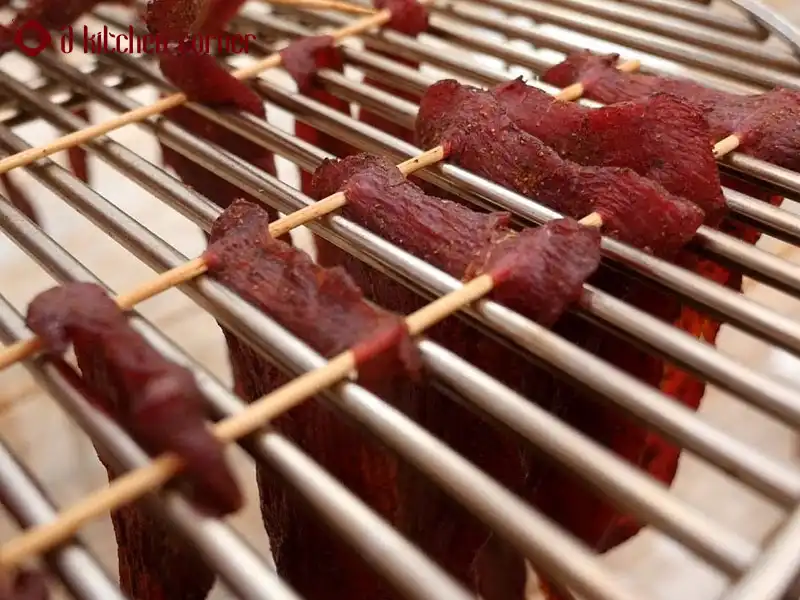
Making jerky with a smoker
Pros
- This approach can be the most useful if you already have a smoker.
- The recommended temperature ranges for jerky consumption are easily maintained with accuracy using electric and pellet smokers.
- These are well-insulated so that they will cook your jerky evenly most of the time.
- Many smokers feature additional controls, such as automatic shut-offs or 24-hour timers. This can make the process of making your jerky easier.
- Your jerky’s flavor is typically improved by smokers as well.
Cons:
- In contrast to a dehydrator, where it is virtually difficult to burn food, it is easier to burn food in a smoker.
- Maintaining the right temperature will take more work with some types of smokers, like charcoal.
Frequently asked questions
Certainly, overdried jerky has a brittle texture and a concentrated salt flavor. Jerky needs to be dried until it is firm yet still flexible. Remember that the jerky will continue to dry after being removed from the dehydrator. So, take it off while it’s still pliable.
The best jerky is made from round roasts of the hind quarters. Long-grained, sinew-free meat from the leg muscles provides consistent jerky that dries uniformly.
Make extruded jerky out of any ground meat if you don’t have access to round roasts to work with. Although whole muscle and extruded jerky have different textures, they are both excellent choices if you want to use more beef parts and make more jerky.
>> Related post: How to dehydrate meat for jerky? A beginner’s guide to making jerky at home
To securely make jerky, a dehydrator needs to attain a temperature of 145°F at the very least. Bacterial growth might be encouraged by the decreased temperature. Jerky will be dried uniformly, reliably, and securely with the proper heat and airflow.
Dehydrate for 3 to 5 hours at 160 degrees in your food dehydrator. When the jerky is dry and bends without breaking, it is ready. Within two weeks, consume after storing in an airtight container at room temperature or in the refrigerator.
A vertical dehydrator has the heating element and fan located at the bottom of the unit, and the trays are stacked vertically on top of each other. This design allows for better air circulation and even drying of the jerky.
On the other hand, a horizontal dehydrator has the heating element and fan located at the back of the unit, and the trays slide in horizontally.
This design may require more frequent rotation of the trays to ensure even drying. Ultimately, both types of dehydrators can be used for making jerky, so it comes down to personal preference and the specific features of each model.
The ideal temperature for dehydrating jerky is between 145°F and 160°F (63°C and 71°C). It is important to follow proper food safety guidelines when making jerky, including using a meat thermometer to ensure that the internal temperature of the jerky reaches at least 160°F (71°C) before consumption.
For a more tender jerky, it is recommended to slice the meat across the grain. To achieve the best results, the meat should not be sliced thicker than 1/4 inch.
Additionally, the strips should be between 1 and 1 1/2 inches wide. Slicing the meat evenly will ensure that it dries evenly.
If you store homemade beef jerky in an airtight container, it can last for one to two months. However, if you keep it in a Ziplock bag in your pantry, it will only last about a week. If you choose to store your beef jerky in the refrigerator, it should last for one to two weeks.
Final thoughts
It’s crucial to choose a food dehydrator that will suit your demands and work with a brand you can rely on while looking for the best one.
The next time you think about making jerky and wish you didn’t have to use your oven all night or monitor your smoker for hours, consider picking up the best dehydrator for jerky. We’ve narrowed it down to make it simple for you to figure out the best product for your needs.
You may be interested:

